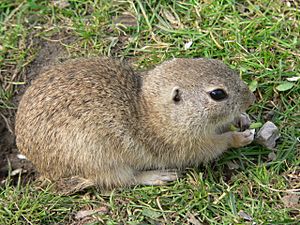Spermophilus facts for kids
Quick facts for kids SpermophilusTemporal range: Middle Miocene - Recent
|
|
|---|---|
 |
|
| European ground squirrel (Spermophilus citellus) | |
| Scientific classification |
|
| Kingdom: | Animalia |
| Phylum: | Chordata |
| Class: | Mammalia |
| Order: | Rodentia |
| Family: | Sciuridae |
| Tribe: | Marmotini |
| Genus: | Spermophilus Cuvier, 1825 |
| Species | |
|
See text. |
|
Spermophilus is a group of ground squirrels. They belong to the squirrel family. For a long time, this group included many different species found across Europe, Asia, and North America.
However, scientists found that the way Spermophilus was defined wasn't quite right. It included animals that were actually more closely related to other groups, like prairie dogs and marmots. Because of this, many North American Spermophilus species were moved into new, separate groups. Now, the true Spermophilus group mainly includes species from Europe and Asia.
Sometimes, these squirrels are called susliks. This name comes from the Russian word suslik. The scientific name Spermophilus means "seed-lovers." It comes from Greek words: sperma (seed) and philos (friend or lover).
Contents
Where Do Spermophilus Live?
Spermophilus squirrels live in open areas. These include grasslands, meadows, steppes, and semi-deserts. They eat low-growing plants. They also use burrows (underground tunnels) as their homes and safe places.
How Do Spermophilus Behave?
These squirrels are active during the day. They mostly live in groups called colonies. However, some species can live alone. They are found in both lowlands and highlands.
During colder months, they hibernate. This means they go into a deep sleep to save energy. Some species can hibernate for up to 8 and a half months each year! In very dry areas, they might also aestivate. This is like a summer sleep during hot or dry times.
Different species of Spermophilus usually live in separate areas. Large rivers often keep their groups apart. But in some places, up to three different species might live near each other. Rarely, two species might even share a colony. Sometimes, different species can breed together if their living areas meet.
What Do Spermophilus Look Like?
Spermophilus squirrels are usually yellowish, light orange, light brown, or grey. Many have faint spots or patterns. Some have orange marks on their heads. Generally, they don't have very strong patterns. An exception is the Speckled ground squirrel (S. suslicus). This species often has brown fur on its back with clear white spots.
Their size changes depending on the species. Their head and body length is about 17 to 40 centimeters (6.7 to 15.7 inches). Before hibernating, the largest Yellow ground squirrel (S. fulvus) can weigh up to 2 kilograms (4.4 pounds). The largest Russet ground squirrel (S. major) can weigh almost 1.4 kilograms (3.1 pounds). However, they weigh much less earlier in the year. Other species are much smaller, often less than 0.5 kilograms (1.1 pounds), even when they are at their heaviest before hibernation. All Spermophilus have a fairly short tail. The tail is about 10–45% of their head and body length.
Spermophilus and People
Ground squirrels can sometimes carry fleas. These fleas can spread diseases to humans. Also, their tunneling can cause damage to buildings or land where people live.
Types of Spermophilus Species
Scientists studied the genes of ground squirrels in 2007. They used a special gene called cytochrome b. This study helped them understand how different groups of squirrels are related. Because of this research, the Spermophilus group was divided into eight new groups. The species listed below are the ones that are still considered true Spermophilus (meaning Spermophilus sensu stricto). These are all found in the Palearctic region, which includes Europe and Asia.
- Spermophilus sensu stricto, Old World ground squirrels
-
- Alashan ground squirrel, Spermophilus alashanicus
- Brandt's ground squirrel, Spermophilus brevicauda
- European ground squirrel, Spermophilus citellus
- Daurian ground squirrel, Spermophilus dauricus
- Red-cheeked ground squirrel, Spermophilus erythrogenys
- Yellow ground squirrel, Spermophilus fulvus
- Russet ground squirrel, Spermophilus major
- Caucasian Mountain ground squirrel, Spermophilus musicus
- Spermophilus nilkaensis
- Spermophilus pallidicauda
- Little ground squirrel, Spermophilus pygmaeus
- Spermophilus ralli
- Spermophilus relictus
- Speckled ground squirrel, Spermophilus suslicus
- Taurus ground squirrel, Spermophilus taurensis
- Asia Minor ground squirrel, Spermophilus xanthoprymnus
Ancient Spermophilus Species
Scientists have found very well-preserved fossils of ancient Eurasian ground squirrels. These fossils helped them learn more about the skulls of these animals. This led to a new understanding of how they are related to other squirrels. As a result, three ancient species from the Pleistocene era were moved into the Spermophilus group. Before, they were thought to be part of the Urocitellus group.
Another ancient species, Spermophilus citelloides, lived in Europe from the Middle Pleistocene to the early Holocene. It seems to be most closely related to the living S. suslicus.
Images for kids
-
Spermophilus suslicus, a species that commonly has clearly white-spotted upperparts
See also
 In Spanish: Spermophilus para niños
In Spanish: Spermophilus para niños


